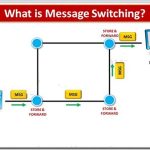Specific Instructional Objectives
At the end of this lesson the student will be able to:
· Understand the need for circuit switching
· Specify the components of a switched communication network
· Explain how circuit switching takes place
· Explain how switching takes place using space-division and time-division switching
· Explain how routing is performed
· Explain how signalling in performed
Introduction
When there are many devices, it is necessary to develop suitable mechanism for communication between any two devices. One alternative is to establish point-to-point communication between each pair of devices using mesh topology. However, mesh topology is impractical for large number of devices, because the number of links increases exponentially (n(n-1)/2, where n is the number of devices) with the number of devices. A better alternative is to use switching techniques leading to switched communication network. In the switched network methodology, the network consists of a set of interconnected nodes, among which information is transmitted from source to destination via different routes, which is controlled by the switching mechanism. A basic model of a switched communication is shown in Fig. 4.1.1. The end devices that wish to communicate with each other are called stations. The switching devices are called nodes. Some nodes connect to other nodes and some are to connected to some stations. Key features of a switched communication network are given below:
· Network Topology is not regular.
· Uses FDM or TDM for node-to-node communication.
· There exist multiple paths between a source-destination pair for better network reliability.
· The switching nodes are not concerned with the contents of data.
· Their purpose is to provide a switching facility that will move data from node to node until they reach the destination.
The switching performed by different nodes can be categorized into the following three types:
· Circuit Switching
· Packet Switching
· Message Switching

Basic model of a switched communication network
In this lesson we shall discuss various aspects of circuit switching and discuss how the Public Switched Telephone Network (PSTN), which is based on circuit switching, works.
Circuit switching Technique
Communication via circuit switching implies that there is a dedicated communication path between the two stations. The path is a connected through a sequence of links between network nodes. On each physical link, a logical channel is dedicated to the connection. Circuit switching is commonly used technique in telephony, where the caller sends a special message with the address of the caller (i.e. by dialling a number) to state its destination. It involved the following three distinct steps, as shown in Fig.
Circuit Establishment:
To establish an end-to-end connection before any transfer of data. Some segments of the circuit may be a dedicated link, while some other segments may be shared.
Data transfer:
· Transfer data is from the source to the destination.
· The data may be analog or digital, depending on the nature of the network.
· The connection is generally full-duplex.
Circuit disconnect:
· Terminate connection at the end of data transfer.
· Signals must be propagated to deallocate the dedicated resources.

Circuit Switching technique
Thus the actual physical electrical path or circuit between the source and destination host must be established before the message is transmitted. This connection, once established, remains exclusive and continuous for the complete duration of information exchange and the circuit becomes disconnected only when the source wants to do so.


